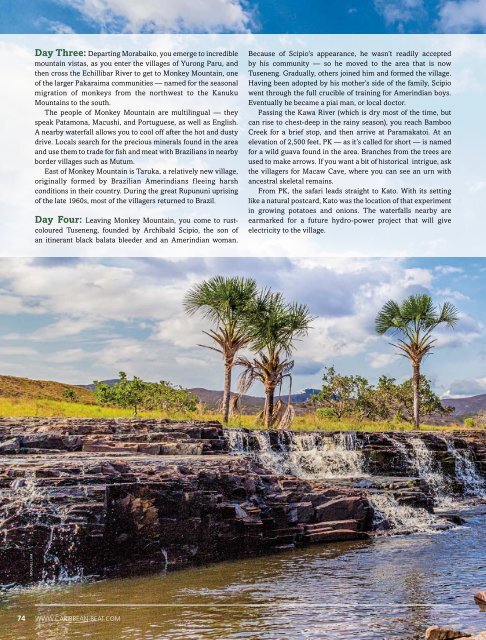Caribbean Beat — 25th Anniversary Edition — March/April 2017 (#144)
A calendar of events; music, film, and book reviews; travel features; people profiles, and much more.
A calendar of events; music, film, and book reviews; travel features; people profiles, and much more.
Create successful ePaper yourself
Turn your PDF publications into a flip-book with our unique Google optimized e-Paper software.
Day Three: Departing Morabaiko, you emerge to incredible<br />
mountain vistas, as you enter the villages of Yurong Paru, and<br />
then cross the Echillibar River to get to Monkey Mountain, one<br />
of the larger Pakaraima communities <strong>—</strong> named for the seasonal<br />
migration of monkeys from the northwest to the Kanuku<br />
Mountains to the south.<br />
The people of Monkey Mountain are multilingual <strong>—</strong> they<br />
speak Patamona, Macushi, and Portuguese, as well as English.<br />
A nearby waterfall allows you to cool off after the hot and dusty<br />
drive. Locals search for the precious minerals found in the area<br />
and use them to trade for fish and meat with Brazilians in nearby<br />
border villages such as Mutum.<br />
East of Monkey Mountain is Taruka, a relatively new village,<br />
originally formed by Brazilian Amerindians fleeing harsh<br />
conditions in their country. During the great Rupununi uprising<br />
of the late 1960s, most of the villagers returned to Brazil.<br />
Day Four: Leaving Monkey Mountain, you come to rustcoloured<br />
Tuseneng, founded by Archibald Scipio, the son of<br />
an itinerant black balata bleeder and an Amerindian woman.<br />
Because of Scipio’s appearance, he wasn’t readily accepted<br />
by his community <strong>—</strong> so he moved to the area that is now<br />
Tuseneng. Gradually, others joined him and formed the village.<br />
Having been adopted by his mother’s side of the family, Scipio<br />
went through the full crucible of training for Amerindian boys.<br />
Eventually he became a piai man, or local doctor.<br />
Passing the Kawa River (which is dry most of the time, but<br />
can rise to chest-deep in the rainy season), you reach Bamboo<br />
Creek for a brief stop, and then arrive at Paramakatoi. At an<br />
elevation of 2,500 feet, PK <strong>—</strong> as it’s called for short <strong>—</strong> is named<br />
for a wild guava found in the area. Branches from the trees are<br />
used to make arrows. If you want a bit of historical intrigue, ask<br />
the villagers for Macaw Cave, where you can see an urn with<br />
ancestral skeletal remains.<br />
From PK, the safari leads straight to Kato. With its setting<br />
like a natural postcard, Kato was the location of that experiment<br />
in growing potatoes and onions. The waterfalls nearby are<br />
earmarked for a future hydro-power project that will give<br />
electricity to the village.<br />
michael lam<br />
74 WWW.CARIBBEAN-BEAT.COM


















